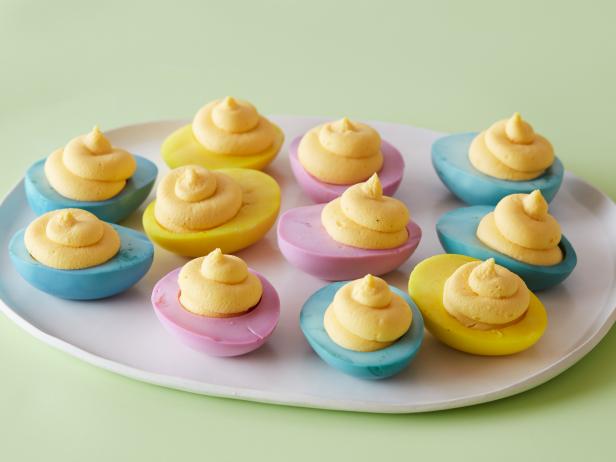Looking for a colorful science experiment? Get the kids (and adults) into the kitchen and use real food to dye deviled eggs. (P.S: The cabbage part is our favorite!)
| Level: | Easy |
| Total: | 1 hr 30 min |
| Active: | 30 min |
| Yield: | 24 deviled eggs |
Ingredients
- 2 teaspoons turmeric
- 3 tablespoons distilled white vinegar
- Kosher salt
- 1 small red beet, peeled and diced
- 1/4 head red cabbage, chopped
- 1/4 teaspoon baking soda
- 12 hard-boiled eggs, peeled, halved and yolks and whites separated
- 1/3 cup mayonnaise
- 2 teaspoons yellow mustard
Instructions
- Combine the turmeric with 1 1/2 cups water in a medium pot. Bring to a simmer over medium heat; gently simmer for 10 minutes. Remove from the heat and stir in 1 tablespoon vinegar and 1/2 teaspoon salt. Let cool for 5 minutes, then transfer to a heatproof container.
- Combine the beets with 1 1/2 cups water in a medium pot. Bring to a simmer over medium heat; gently simmer for 20 minutes. Remove from the heat and stir in 1 tablespoon vinegar and 1/2 teaspoon salt. Let cool for 5 minutes, then strain into a heatproof container.
- Combine the cabbage with 2 1/2 cups water in a medium pot. Bring to a simmer over medium heat; gently simmer for 20 minutes. Let cool for 5 minutes, then strain half into a heatproof container and stir in the baking soda and 1/2 teaspoon salt. Strain the remaining liquid into a heatproof container and stir in 1/2 teaspoon salt.
- Add 6 egg whites to each container and let soak until the desired color (yellow, pink, lilac and teal), up to 1 hour. Drain the egg whites on a paper towel-lined plate before serving.
- Meanwhile, transfer the yolks to a food processor. Add the mayonnaise, mustard, remaining 1 tablespoon vinegar and 1/4 teaspoon salt and pulse until smooth and creamy. Transfer the yolk mixture to a pastry bag fitted with a small round tip. Pipe swirly dollops of the mixture into each dyed white.
Nutrition Facts
| Serving Size | 1 of 24 servings |
| Calories | 59 |
| Total Fat | 5 g |
| Saturated Fat | 1 g |
| Carbohydrates | 1 g |
| Dietary Fiber | 0 g |
| Sugar | 1 g |
| Protein | 3 g |
| Cholesterol | 76 mg |
| Sodium | 88 mg |
Reviews
The blue color was a bit less vibrant (or perhaps will simply take a bit longer to steep) than the beet (which was very fast and intense), and I added a very small amount of the beet dye to the lilac cabbage dye (the one with no baking soda) and it made it a bit more intense. The turmeric did a decent job of coloring the egg yellow. I still have the lilac, teal and yellow eggs steeping in the fridge. I used hard-cooked quail eggs for this as an experiment. They are very cute and I will do this for my daughter’s baby shower next month–a fancy luncheon with amuses bouches and mignardises.
The instructions are for 3 colors of dye, but it says to put 6 egg halves into each of 4 colors. Should there be instructions another color, or did it get changed to only 3 but not updated completely?
I found the amount of fluid needed varies based on the dish. Unless you have 4 of the same exact dish the level of fluid will vary for soaking the eggs. I increased the amount based on size of dish to assure enough liquid to cover the egg halves. Be sure to experiment with soak times. 1hr gives them a slight hue. I soaked some for 3 hrs and they came out vibrant but darker, which may not be your intention.
This is a great recipe. I buy brown eggs from a farm and this recipe allows me to bring some color back into my Easter. Did not try dying with cabbage but left my whites in the turmeric and beet coloring for over an hour and the colors were very vibrant when they came out.
These were fairly easy to do but was more time consuming since it takes longer for the coloring to absorb and with 1 1/2 C I could only do 2 eggs per color. My color isn’t as intense as the picture but I’m happy with them!
Great, cant wait to make them!
